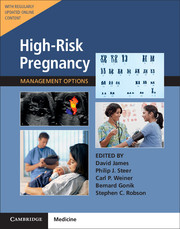Book contents
- Frontmatter
- Contents
- List of Contributors
- Preface
- Section 1 Prepregnancy Problems
- Section 2 Early Prenatal Problems
- 5 Bleeding and Pain in Early Pregnancy
- 6 Recurrent Miscarriage
- 7 Screening for Fetal Abnormality in the First and Second Trimesters
- 8 Invasive Procedures for Prenatal Diagnosis
- Section 3 Late Prenatal – Fetal Problems
- Section 4 Problems Associated with Infection
- Section 5 Late Pregnancy – Maternal Problems
- Section 6 Late Prenatal – Obstetric Problems
- Section 7 Postnatal Problems
- Section 8 Normal Values
- Index
8 - Invasive Procedures for Prenatal Diagnosis
from Section 2 - Early Prenatal Problems
- Frontmatter
- Contents
- List of Contributors
- Preface
- Section 1 Prepregnancy Problems
- Section 2 Early Prenatal Problems
- 5 Bleeding and Pain in Early Pregnancy
- 6 Recurrent Miscarriage
- 7 Screening for Fetal Abnormality in the First and Second Trimesters
- 8 Invasive Procedures for Prenatal Diagnosis
- Section 3 Late Prenatal – Fetal Problems
- Section 4 Problems Associated with Infection
- Section 5 Late Pregnancy – Maternal Problems
- Section 6 Late Prenatal – Obstetric Problems
- Section 7 Postnatal Problems
- Section 8 Normal Values
- Index
Summary
Introduction
Invasive prenatal tests, including chorionic villus sampling, amniocentesis, fetal blood sampling, and fetal tissue biopsy, allow examination of fetal genetic material and tissue and provide information for the management of fetal infections and anemia. The specific test employed is usually dependent on the indication, parental wishes, and the timing of preceding screening tests.
With the arrival of noninvasive prenatal testing (NIPT), the landscape of screening and prenatal diagnosis is rapidly changing. A comprehensive understanding of prenatal diagnostic techniques is required for clinicians who provide counseling and offer choice to their patients. Furthermore, achieving technical competency is a requirement for practitioners involved in prenatal diagnosis, and individuals must have evidence that they are maintaining competency.
This chapter addresses the indications for and the recommendations for training, clinical governance, and conduct of the most frequently employed invasive diagnostic techniques.
Indications for Invasive Diagnostic Procedures
The indications for ultrasound-guided invasive diagnostic procedures are:
• A high-risk aneuploidy screening result (after a “combined” test, or second-trimester serum screening or noninvasive prenatal testing)
• Structural anomalies or markers for fetal aneuploidy identified at the dating scan or fetal anomaly screening
• Previous history of pregnancy affected by aneuploidy or genetic disease
• Family history of genetic disease with a high risk of recurrence in the fetus
• Evidence of fetal anemia, including increased middle cerebral artery peak systolic velocity (MCA PSV) and/or signs of fetal hydrops
• Diagnosis of fetal bullous and hyperkeratotic disorders, muscular dystrophies, metabolic diseases, and fetal tumors
• Suspected fetal viral infection, evidence of recent maternal infection on virology testing, and fetal ultrasound markers including fetal hydrops
The commonest indication is a high risk of aneuploidy.
Aneuploidy Screening and Diagnostic Tests
Currently trisomy 21 screening may be performed in both the first and second trimesters, and the cutoff for a high-risk result in the UK system is 1 in 150. Women undergoing first-trimester combined screening should obtain a result within the time frame for chorionic villus sampling (CVS). Where secondtrimester serum screening is undertaken, amniocentesis is the procedure of choice as falsepositive results due to confined placental mosaicism are less likely.
- Type
- Chapter
- Information
- High-Risk Pregnancy: Management OptionsFive-Year Institutional Subscription with Online Updates, pp. 190 - 206Publisher: Cambridge University PressFirst published in: 2017



